Contact
Department of Ecology, S, Wildlife Ecology Unit

In recent decades, lynxes have returned to their former territories in southern Sweden. Heather Hemmingmoore demonstrates in her thesis from Swedish University of Agricultural Sciences why this recolonization has been so successful. There are plenty of habitats. The lynxes in the south did not lose contact with the population in central Sweden and therefore have not lost genetic diversity. In addition, management has facilitated lynx dispersal.
The Eurasian lynx, once hunted to the brink of extinction in the early 20th century, has naturally recolonized Sweden, with a current population estimate of around 1200-1600 in Sweden. As recently as 2003, there was no permanent lynx population in southern Sweden. Since then, the population in the region has recovered to approximately 345 individuals in the winter of 2021/2022, which is more than double the minimum target of 148 lynx for the region (extending from Mälaren and Vättern and south).
Heather Hemmingmoore has studied the journey of lynx back to their former range, a recolonization that has posed many challenges for the animals.
For a recolonization to succeed, there must be sufficient suitable habitats. Researchers have been tracking lynxes in Sweden since 1996, initially using VHF radio collars and then GPS collars. Heather Hemmingmoore has used this data to study how lynxes utilize the landscape. By using maps she found that more than half of the land in southern Sweden is suitable habitat for lynxes.
"So, the first criterion is fulfilled—there are places where lynxes can establish their territories. They prefer forests and rugged terrain," says Heather Hemmingmoore, SLU Grimsö Wildlife Research Station, SLU.
With a low population density it can be challenging to find mating partners. The thesis shows that the population in the south had slower growth than that in central Sweden initially. Yet no genetic diversity has been lost. Heather Hemmingmoore came to this conclusion after carrying out DNA analysis on samples from dead lynx submitted to the SVA.
“That's good news! Lynxes have an impressive ability to disperse for hundreds of kilometers, even across unsuitable habitats like farmland or developed areas. There is constant genetic exchange between lynxes in central and southern Sweden,” says Heather Hemmingmoore.
Sweden has had a goal for lynxes to spread southward. In northern Sweden, lynx mainly eat reindeer, which is of course a problem for reindeer herding. In other parts of Sweden, roe deer are the main prey.
The lynx population has established itself in southern Sweden despite some legal hunting and potential poaching. The results show that large predator populations can expand even without protected areas.
Heather Hemmingmoore hopes this example of a successful recolonization could serve as a reference for the restoration of large carnivores worldwide. Although all predators and landscapes are unique, of course.
“It illustrates the importance of connectivity and the need for careful management strategies that encourage human tolerance and facilitate population growth. As we look towards the future, the ability of lynx to reclaim their ancestral homeland reminds us that with the right conditions and protections, nature has an extraordinary ability to recover”, says heather Hemmingmoore.
The recolonization of lynx from central to southern Sweden : A success story